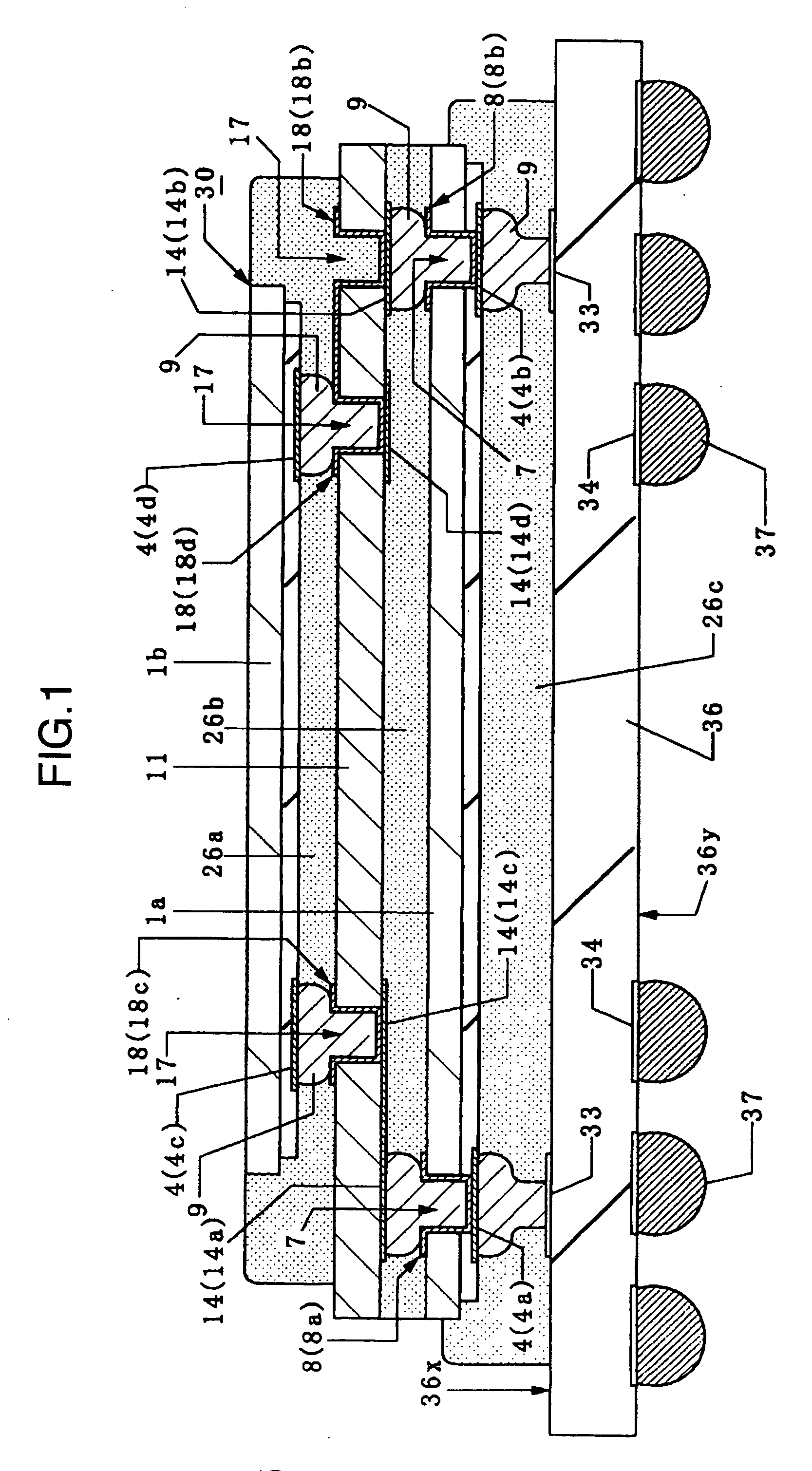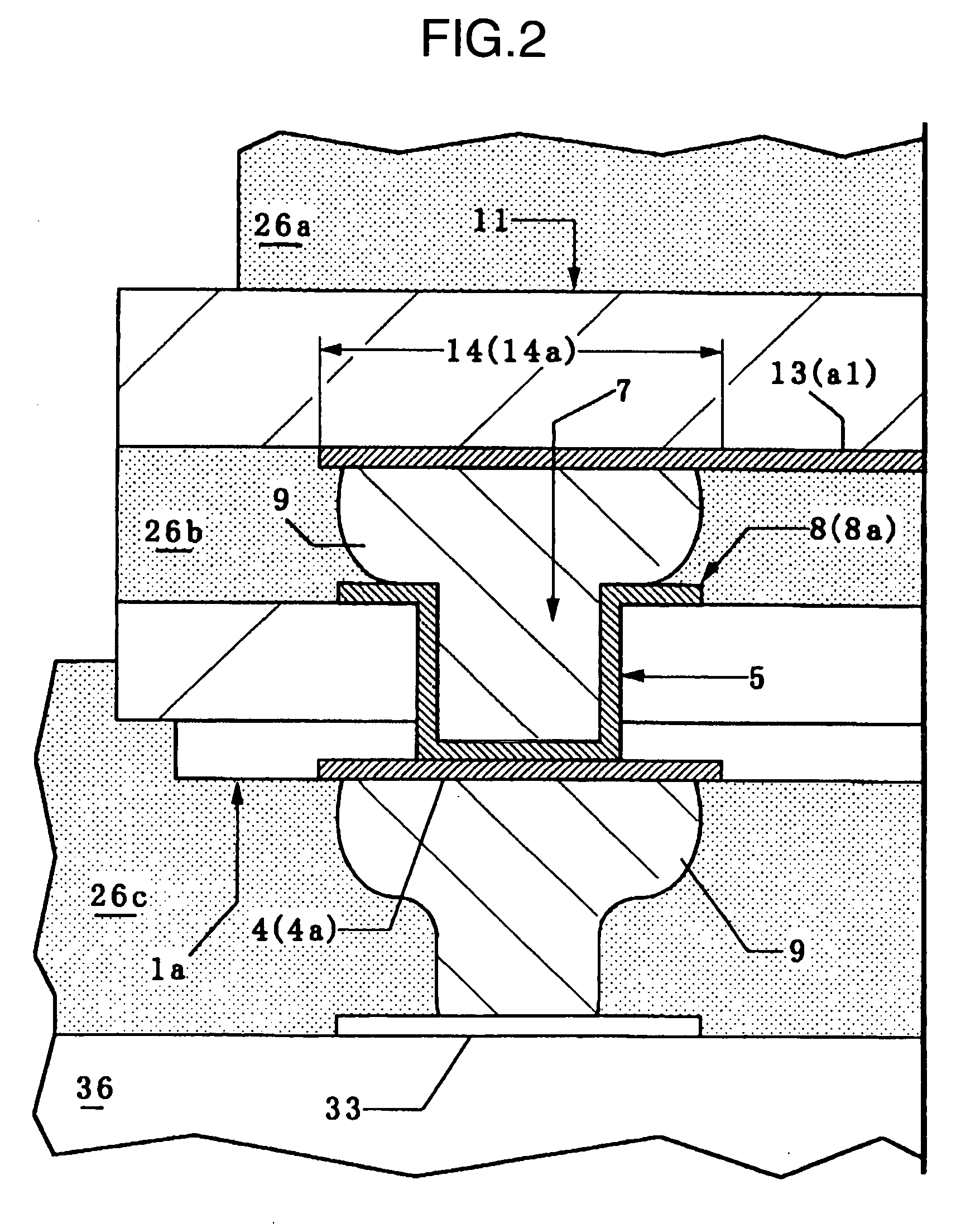Semiconductor device and method of manufacturing thereof
a semiconductor device and semiconductor technology, applied in semiconductor devices, semiconductor/solid-state device details, electrical apparatus, etc., can solve the problems of difficult high-speed transmission, high wiring density on mounting substrates, and long wiring length between chips, so as to shorten the length reduce the cost of the semiconductor device, and improve the effect of transmission speed
- Summary
- Abstract
- Description
- Claims
- Application Information
AI Technical Summary
Benefits of technology
Problems solved by technology
Method used
Image
Examples
embodiment 1
[0076] In the embodiment 1, a semiconductor device having a lamination in which different kinds of semiconductor chips are three-dimensionally laminated one upon another, an interposer chip (an intermediate wiring substrate) being interposed therebetween.
[0077] FIGS. 1 to 17b are views for explaining the semiconductor device in the embodiment 1 of the present invention, that is,
[0078]FIG. 1 is a schematic view illustrating the configuration of the semiconductor device;
[0079]FIG. 2 is an enlarged schematic sectional view illustrating a part shown in FIG. 1;
[0080]FIG. 3a is a schematic sectional view illustrating an entire configuration of a semiconductor chip located at the lowermost stage in a chip lamination shown in FIG. 1:
[0081]FIG. 3b is an enlarged schematic sectional view illustrating a part in FIG. 3a;
[0082]FIG. 4a is a schematic sectional view illustrating an entire configuration of a semiconductor chip located at the uppermost stage in the chip lamination shown in FIG...
embodiment 2
[0202] FIGS. 25 to 26c show a semiconductor device in an embodiment 2 of the present invention, in which FIG. 25 is a schematic sectional view illustrating a configuration of the semiconductor device, FIG. 26a is a schematic sectional view illustrating a semiconductor chip located at the uppermost stage of a chip lamination, FIG. 26b is a schematic sectional view illustrating an interposer chip and FIG. 26c is a schematic sectional view illustrating a semiconductor chip located at the lowermost stage.
[0203] The semiconductor device in this embodiment 2 has the same configuration as that of the embodiment 1, except that the chip lamination has a different structure. As shown in FIG. 25, in the chip lamination 30a in this embodiment 2, a semiconductor chip 1d is laminated on a semiconductor chip 1a through the intermediary of an interposer chip 11a, the semiconductor chip 1d having an external size which is larger than that of the semiconductor chip 1c.
[0204] The upper stage semicon...
embodiment 4
[0218]FIG. 28 is a schematic sectional view illustrating a configuration of a semiconductor device in an embodiment 4.
[0219] Explanation has been made of the three-dimensional lamination of different kinds of upper and lower semiconductor chips between which the interposer chip 11 is interposed in order to materialize operative three-dimensional connection between the upper and lower semiconductor chips in the embodiment 1. However, in this embodiment 4, concave electrodes (8a, 8b) are formed at electrode positions (electrode pads 4a, 4b) on the rear surface 1y side of a lower stage semiconductor chip 1e, at which connection to an upper stage semiconductor chip is required, and simultaneously, a rewiring layer connected thereto and concave electrodes (8a, 8d) connected to the upper stage semiconductor chip 1b are formed. Thus, the upper stage semiconductor chip 1b is electrically connected to the lower stage semiconductor chip 1e, direct thereto.
[0220] Thus, there may be obtained ...
PUM
 Login to View More
Login to View More Abstract
Description
Claims
Application Information
 Login to View More
Login to View More - R&D
- Intellectual Property
- Life Sciences
- Materials
- Tech Scout
- Unparalleled Data Quality
- Higher Quality Content
- 60% Fewer Hallucinations
Browse by: Latest US Patents, China's latest patents, Technical Efficacy Thesaurus, Application Domain, Technology Topic, Popular Technical Reports.
© 2025 PatSnap. All rights reserved.Legal|Privacy policy|Modern Slavery Act Transparency Statement|Sitemap|About US| Contact US: help@patsnap.com



